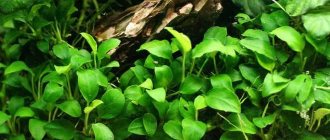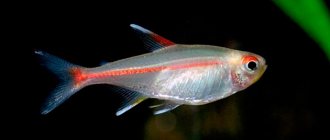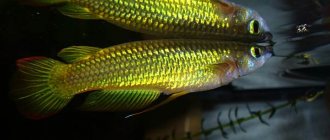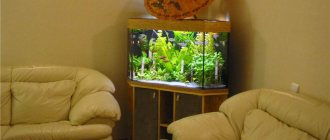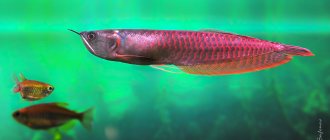Deciding which of the aquarium inhabitants is more beautiful is a thankless task and, in general, initially doomed to failure. Even in individual groups of fish, it will be difficult to identify a clear leader in beauty: they are too different. I, like any aquarist, have my favorites. And if we talk about cichlids, then the first place here will probably be taken by Altolamprologus calvus, which is sometimes called the “Mother of Pearl Fairy”.
I, like any aquarist, have my favorites. And if we talk about cichlids, then the first place here will probably be taken by Altolamprologus calvus, which is sometimes called the “Mother of Pearl Fairy”.
Appearance
The white (pearl) variety, described in 1978 by Poll, occurs in the southwestern part of the lake, along the coast between Kapampa in the Congo and Cape Chaitika in Zambia.
Finally, the yellow variation, whose body is colored in orange-yellow tones, was first discovered by researcher R. Krüter in 1988. It lives on a small stretch of the Zambian coast from Nkamba Bay to Chilanga.
When the Black Altolamprologus is kept in an aquarium with dark soil, its coloration becomes very dark, and the white spots sparkle and glow. The stripes of the white variation are less pronounced on light soil, although, along with spots, they stand out strongly when fish are kept on dark soil. The white variation is strikingly different from the black one in that its spots extend over the entire surface of the ventral fins.
Illustrated variations of Altolamprologus calvus: black "Congo" (1, Matthew Floyd); “yellow” from the Nkamba Bay area (2) and Chilanga (3, ill. www.tanganyika.ru/fishdesc.php?fid=4); “pearl”/white (4, stanchung; www.my-mac.net/forum/viewtopic.php?f=30&t=2850)
Altolamprologus calvus has a flattened, tall body, a steep, sloping forehead, stripes more prominent on the head and neck, and brilliant white spots covering 2/3 of their body.
Description
Despite the similarity of many cichlids, it is almost impossible to confuse the pearl fairy with other representatives of the genus.
The maximum size of Altolamprologus calvus reaches 15 cm, the average size is 12-13 cm. The fish reaches this size by 5-6 years (with a life expectancy of up to 8 years).
A distinctive feature is an elongated head with an elongated mouth, a sloping forehead, a narrow body, compressed from the sides. This structure is determined by the cichlid’s lifestyle, the need to squeeze into crevices after prey.
In addition to its recognizable “profile,” the fish is famous for its interesting, attractive colors. The color is varied, ranging from dark to light.
The most common options:
- black (black);
- white (white);
- yellow (yellow);
- zebra (similar to white).
There are vertical dark stripes throughout the body. And from the gill arches to the tip of the tail, the calvus is covered with bright, pearlescent small spots. This gives the fish a slightly fantastic, “cosmic” look.
In an excited state, the color of the fish changes, it becomes darker, stripes and spots are less pronounced. Sometimes the Calvus cichlid can have an almost black, charcoal tint, or, on the contrary, a light, gray color.
Males and females of Calvus
By about 4-5 years of age, mature males reach a maximum length of 15 cm (average 10 cm), while females are only 8 cm (average 6 cm). In addition, as they mature, the body of males becomes taller than that of females, and their fins become more elongated. Distinction by sex is possible at the age of 8-10 months, when the male continues to actively grow, while the length of the female becomes slightly more than 5-6 cm. After several more months of keeping the Calvus colony in the aquarium, they will begin to build a hierarchical structure. During this period, fights intensify and, accordingly, the coloring of the dominant fish will become more spectacular.
Systematic position
In 1898, Bolenger discovered two new species, Lamprologus compressiceps and Lamprologus fasciatus, in Lake Tanganyika, placing them in the genus Lamprologus. The species "Calvus", due to the lack of significant differences, was designated as a color variation of the species "compressiceps", and was isolated only in 1978 by Paul. The first specimen of A. compressiceps was caught in Mpulungu (Zambia) in 1898, and A. calvus on July 7, 1977 in the area of Cape Chipimbi (Zambia).
In 1986, the two species were assigned to the separate genus Altolamprologus. Currently, the genus Altolamprologus includes three species: A. compressiceps (Boulenger, 1898), A. calvus (Poll, 1978) and the unscientifically described species A. sp. "Compressiceps Shell". The species name "fasciatus" is not scientifically justified. In 1985, Colombe and Allgayer applied this name to Neolamprologus fasciatus, which was confirmed in 2007 by Koblmüller.
The genus name comes from two Latin words: altum, meaning “high,” and lampas, meaning “light, torch.”
Altolamprologus calvus (Poll, 1978) is very similar to its relative A. compressiceps and differs from it only in a more elongated and flattened snout, as well as in the absence of scales on the head. The latter feature is reflected in the species name Altolamprologus calvus (Poll, 1978) (calvus is Latin for “bald”). In turn, the species name Altolamprologus compressiceps comes from two Latin words: compression, meaning “compressed, flattened”, and ceps (cephala) – “head”.
Feeding
Representatives of this species are predators. They specialize in catching juvenile cichlids and invertebrates among the rocks of rocky terrain. Their flat body is hardly noticeable when viewed from the front and back, and at the same time allows them to easily pass through narrow crevices. If necessary, it bends at very large angles. Due to the stated natural behavior of fish, they should not be kept with small specimens, which will certainly be eaten.
It is worth noting that the calvus has very reliable protection in the form of thick scales with horny bristles, which prevents injury from the sharp edges of rocks and, at the same time, saves it from attack by aggressive cichlids. During an attack, the calvus bends so that the scales stick out towards the offender. Thus, the latter does not cause significant damage to altolamprologus, but can injure the mouth on the bristly body.
During hunting, Altolamprologus slowly moves along the bottom. Once the prey is detected, it directs all its attention to the victim, moves back slightly, and then suddenly throws itself out. This behavior is also characteristic of the species Dimidiochromis compressiceps, which has the same flattened high body.
In an aquarium, fish eat live and frozen food, with the exception of beef heart and other animal products. Dry food is also eaten eagerly, but emphasis should not be placed on it.
Habitat in nature
Altolamprologus calvus is endemic to Lake Tanganyika in Africa. Its habitat is warm fresh waters of increased hardness, its habitat is a rocky coastline.
Under natural conditions, the calvus cichlid hides in rock crevices in case of danger. She uses them for reproduction and spawning.
In natural conditions, Altolamprologus calvus feeds mainly on small fish. However, the predator is too slow to chase prey; it prefers to wait for it in ambush, content with the “yawning” fry and the eggs found.
Altolamprologus compatibility
Although Calvus are territorial, they are usually peaceful towards their neighbors and can be an excellent addition to the Tanganyika cichlid community. Since representatives of this species are very shy, it is better to avoid housing them with aggressive species, for example, mbuna. Preferred neighbors are fish of the genera Julidochromis, Neolamprologus, Cyprichromis and Tanganyika catfish of the genus Synodontis. Depending on the size of the aquarium, calvus can be kept in pairs or as a whole colony.
The fish must be kept in an aquarium that reproduces the biotope of Lake Tanganyika. At the bottom of the container, covered with a layer of river sand, a pile of stones in the form of caves should be placed. Dim lighting will create a calm environment and allow you to see the calvus more often. Adults are indifferent to areas with aquatic vegetation and do not swim there, but these areas will serve as a reliable refuge for juveniles.
Water indicators for maintenance: temperature 24 – 27 °C; pH: 7.5 – 9.0; total hardness 8-20 degrees (143 – 357 ppm); electrical conductivity – 600-630 µS/cm.
Fish diseases
The main cause of most diseases of cichlids from Lake Tanganyika is unsuitable housing conditions and poor quality food, which often leads to a disease such as African bloat. If the first symptoms are detected, you should check the water parameters and the presence of high concentrations of hazardous substances (ammonia, nitrites, nitrates, etc.), if necessary, bring all indicators back to normal and only then begin treatment. Read more about symptoms and treatment methods in the section “Diseases of aquarium fish”.
Calvus propagation
In an aquarium, reproduction is possible. The fish reach sexual maturity at the age of 15-18 months. In medium-sized aquariums (less than 200 liters), calvus usually spawn in pairs, while in larger aquariums one male spawns successively with two or three females. A mature female stops running away from the male and begins to expose herself to him. Producers acquire intense mating coloration. As a substrate, fish use the surface of stones in crevices, sea shells, PVC pipes and other secluded places. As a rule, the clutch size is 80 eggs (maximum 200 eggs). They are yellowish-gray formations with a diameter of 2.5 mm. The incubation period lasts 72 hours, after a week the fry begin to swim, but leave the shelter only after three weeks at a length of 7-8 mm. The female guards the clutch and young, while the male defends the nearby territory.
When feeding on Artemia nauplii or microworms, the juveniles develop quite quickly, reaching 1.5 cm by the second month. By the second year, the fish are about 6.5 cm long.
With an average life expectancy of calvus of 10 years, they reproduce within 5-6 years (peak sexual activity at the age of 3 years). Typically, individuals spawn every 30-35 days.
The illustration shows the habitat of black (red line), yellow (yellow line) and white (white line below) variations of Calvus.
Planet TANGANYIKA
Igor Shelestov. Altolamprologus calvus "black". Story
calvus (from Latin) - bald, altus (from Latin) - tall
Altolamprologus calvus “black fin” adult male
Among the cichlids of Lake Tanganyika, there are species that, despite all the inconstancy and vagaries of fashion, will always be at the forefront of the most popular species among aquarists. Altolamprologus calvus "black" is one of these cichlids. Without exaggeration, they can be called the iconic cichlids of Lake Tanganyika. At one time, I, like many other aquarists, was attracted by the exceptional appearance of this fish. Unusually sharp features of appearance coupled with a fantastically attractive outfit reminiscent of a starry night sky. The color of Altolamprologus calvus “black” is so impressive that it attracts the attention not only of cichlid admirers, but also of many other aquarists who are not known to have any special predilection for cichlidae. The body of an adult male and female in a normal and excited state has a blackish, even charcoal color. An amazing scattering of pearls begins behind the gills of the fish and covers the entire body, right up to the caudal peduncle, moving onto the unpaired fins.
Altolamprologus calvus “black fin” sexually mature female
When photographing fish, as a rule, you always strive to capture the fish at the peak of emotions, at the moments when it is most effectively colored. It is precisely this way, intensely black, with scatterings of luminous sparkles that black calvuses remain in the best photographs and in our visual memory. But it would be a mistake to think that calvus are always black as coal. The color of A. calvus “black” is far from constant and very variable.
At moments of greatest excitement, the calvus actually become very black and even charcoal, to the point that the pearly scattering on the body disappears. But this outfit is not permanent. “Combat” coloring may soon become noticeably lighter and fade to light gray tones. The head may turn black, but the body may remain light; the head and fins may remain black; vertical light stripes behind the head may stand out clearly. All these color metamorphoses, in addition to the color of the surrounding landscape, depend on the mood of the fish, its condition, age and, of course, on the conditions in the aquarium. For example, on white sand the color of the fish inexorably brightens and at some moments Altolamprologus calvus “black” more closely resembles specimens of A. calvus “white”, although, in fairness, the charcoal color of the spawning period will not be spoiled by white sand. The impressive black-pearl color also marks the maturation period, when calvaus actively compete with each other.
Like all representatives of the genus Altolamprologus, Calvus are characterized by extremely slow growth. According to my observations, the period from the beginning of independent feeding of the fry to a size of 2 - 3 cm is especially “hopeless” in this sense. With the transition to larger food items, “things” move from a dead point and the fish increase noticeably. As the year approaches, the flock of juvenile Altolamprologus calvus “black” begins to vary in size. At this stage in the life of the calvus, the maturation period begins and is accompanied by extremely active competition in a school of young fish. There is no trace left of the Slowness of the fish; the fish actively move, communicate, periodically donning outfits as black as a raven’s wing. The competition between young fish cannot be called particularly fierce, but from time to time some of them can be seen pushed into the upper area of the aquarium. Traditionally, in order to grow good lamprologus, it is important to raise them together from a young age. This is not only the most competent, but also the most interesting. Possessing adult “top specimens” is only a small part of a long and interesting period of growing calvus and more. All stages of the development of your pets will pass before your eyes, you will learn to feel and understand fish. It all starts, of course, with the acquisition of a good, strong fry. It is better if it is a group of 8 - 10 copies. In this case, you have a good chance of getting an acceptable “gender alignment”, in addition, the fish will feel much better in a school. As a rule, it is better to leave the choice of a partner and the formation of a pair to the fish themselves. They themselves will show “the object of their passions.” It is also worth remembering that the key to a harmonious, stable union is very often the presence of so-called “extra” individuals living nearby.
The conditions for keeping and breeding Altolamprologus calvus in the aquarium are common to all cichlids of Lake Tanganyika: T = 25° - 26° degrees, pH = 7.5 - 9, dGH = 10° - 20° degrees.
Water should contain a minimum amount of harmful nitrogen compounds, which is achieved by regular water changes, active aeration, filtration and thorough cleaning of the aquarium. Water exchange at normal fish stocking density is normally approximately 20-25% of the volume per week. The water of urban water supply systems is often disinfected with chlorine, and altolamprologus are very sensitive to this substance, as many Moscow aquarists have seen. Water is especially actively disinfected in the spring, when reservoirs contain especially a lot of organic matter. Aquarists solve this problem with fractional water changes, when a very small percentage is changed at a time. At the same time, chlorinated water has time to be neutralized by the organics of the aquarium water and does not destabilize the aquarium environment. Many aquarists use filter systems that completely free the water from unwanted impurities. You can get rid of chlorine using air conditioners sold in pet stores; no one has canceled the good old, but often very inconvenient method of settling water, as well as strong aeration for several hours. In a community aquarium with Tanganyika cichlids, Altolamprologus calvus can keep company with a wide variety of animal-eating species. Due to their inactivity, an adult large pair, for separate keeping, can be content with a 100-120-liter aquarium with plenty of shelter.
Nervous play of fins, sharply changing color, demonstration of spectacular outfits to each other - we observe all this during the period of maturation of young calvuses. Pisces are actively searching for a partner, and are also trying to find more comfortable hiding places. A ready female is no longer in a hurry to run away from the male, but deliberately exposes herself to him. At these moments, the coloring of both fish becomes especially impressive. The partners' jet-black outfit contrasts with the almost milky white at the back of the head and lower on the sides. It must be said that the color of the female during this period is no less spectacular than the color of the male. Here again, I note that the color of the fish at these moments is also inconsistent, it reaches a peak and fades depending on what is happening in the aquarium. It’s good if there are narrow crevices in the stones in the aquarium, the calvus pay attention to them first of all. The female can barely squeeze into another crevice, but you can be sure that she is more comfortable here than in the nicest and most spacious cave. Closer to spawning itself, mating games take place close to the shelter chosen by the fish. The female Altolamprologus calvus lays eggs in the cave cavity and climbs inside, covering it with her own body. The male fertilizes the clutch and subsequently guards the nest from the outside. In an aquarium, spawning burrows in rocks can be successfully replaced with sea shells.
The male, in the heat of love games, often literally pushes the female into the cavity of the shell, and often tries to climb in after her. Outside the spawning period, a female who is not ready for spawning can temporarily use a shell or the same cave as a shelter from an overly annoying male. Later, she will lay eggs here, which she can arrange in a cluster if the shell cavity is small, and more evenly if she can somehow turn around in it. The male, if the size of the spawning ground allows, while fertilizing the eggs, can partially penetrate inside the shell, but more often he simply moves above its neck. After spawning, the female does not appear from the shelter for a long time, which worries aquarists who are dealing with altolamprologus for the first time. But nothing terrible happens, it’s just that the female has begun the period of “incubation” of the clutch.
The caudal fin, which is often visible from the outside, flutters - the female ventilates the clutch with her fins. Sometimes it is enough to lightly tap the glass for the female to instantly climb inside to the maximum depth. Several times a day, if the situation nearby is calm, she leaves the place of voluntary “imprisonment” and then her strongly sunken stomach can be observed. Due to a long stay in the shell, the cavity of which is twisted into a spiral, the body of the female Altolamprologus calvus is also slightly curved. At that moment you can feed her by putting the food right in front of her nose. But parental instinct does not always allow the female to feed calmly while incubating the clutch; the situation around may be too uneasy. At the moment when the female is “on her eggs”, the male Altolamprologus calvus “black” fervently attacks all objects approaching the shell. Fish, which the male preferred to avoid outside spawning periods, now avoid his territory. The object of the male’s attack can be the net, your hand, or anything else brought to the nest. The bites of an adult male can be quite noticeable.
According to my observations, the duration of active reproductive function of Altolamprologus calvus “black” is approximately 5 - 6 years. The peak of spawning activity and productivity occurs at the age of about 2 - 4 years, when altolamprologus are able to regularly, once every 2 months, and sometimes more often, bear offspring. On average, productivity is about 60 - 70 eggs, although maximum figures can exceed well over a hundred. The eggs of this species, like other representatives of the genus, are large, up to 2.5 cm in diameter, and most often have a pale yellow or grayish color. The fry is about 1.5 - 2 cm in size and is not much different in color from the fry of Altolamprologus compressiceps. It is noteworthy that among A. compressiceps there are georaces that are surprisingly similar in color to Altolamprologus calvus “black”. For example, this compressiceps from the coast of Tanzania:
Altolamprologus compressiceps Kipili Tanzania
About three weeks after spawning, large, approximately 6 mm. speckled fry spill out onto the bottom near the shell. You may not notice them right away, since the protective outfit disguises them among soil particles. At this moment, the male may pose a great danger to them and a significant proportion of the young may be eaten. Perhaps the fry that have swum away from the nest is no longer perceived by the male as his own offspring, but as strangers who represent prey, because in nature, where there is a fierce struggle for existence, such a small thing is a desirable target for many mouths. One way or another, at the moment of the start of independent feeding, the phase of active protection of the fry in Calvus ends. It should be noted here that a significant portion of the diet of Atolamprologus calvus in nature consists of small fish. Quite slow by nature, Altolamprologus calvus “black” cannot pursue prey for a long time, and therefore waits for it, being in ambush and making short sharp attacks. In an aquarium, where they are provided with a varied and high-calorie food ration (shrimp, shellfish, insect larvae, good dry food), they most often forget about the vain fate of the hunter. More than once I had to observe the Calvus hunting for Cyprichromis caviar. The female Cyprichromis habitually “dropped” the egg and was immediately grabbed by a nearby calvus with lightning speed. He didn’t “run” or fuss, he just settled quietly next to her and waited for his chance.
The holotype of Altolamprologus calvus was caught near the village of Kipimbi, on the border between Zambia and Congo, and was named “black calvus”. The species received a scientific description in 1978 in the works of the Belgian Max Poll. It was also known as “stellate compressiceps”. Despite the sonorous commercial names of the various georaces of black calvus, they do not have such fundamental differences from each other. The differences are clearly visible and are important for people deeply immersed in this topic. One example of a slight, but at the same time, spectacular difference in color is the presence of black Altolamprologus calvus in a number of Congolese and Zambian races
pectoral fins resembling a black translucent veil. Not only the pectoral fins, but also the pelvic fins, as well as the lower part of the body, can be expressively black. This became the reason for the commercial name Altolamprologus calvus "black fin". Another frequently encountered “trade epithets” on the same topic are “black pectoral”, “ink fin”. The black form of A. calvus “black” is very common in the lake and its range covers the coast of Congo and Zambia. Altolamprologus calvus, unlike the closest and related species Altolamprologus compressiceps, does not have a large number of color variations, although among the same black calvus, due to its wide distribution and if you look closely, there are a lot of differences. Aquarists are well aware of the golden form of Altolamprologus calvus "gold" found in Nkamba Bay, as well as the white race - "white" found between Chaitika and Capemba. These are undoubtedly interesting variations, but still much inferior in popularity to black calvus.
To date, there is evidence of the presence of Altolamprologus calvus "black" between Tembwe and Cape Kachese. Information about new populations of Altolamprologus calvus found along this very extensive coastline is likely to be updated as more detailed research is carried out. According to my observations, among the different geographical races of Altolamprologus calvus there are individuals with their own characteristics not only in behavior, which goes without saying, but also in the manner of moving under water. Over more than twenty years of keeping and breeding black calvus, I kept several lines of these fish. One of them differed sharply from the others in its manner of moving above the ground, dramatically lifting its tail upward when examining objects at the bottom. This manner was not a property of any individual specimen, but was a property of one of the lines of black calvus. In my other Altolamprologus calvus “black” this was not even close to observed. I think you will find a lot of new and interesting things if you take a closer look at these fish. Good Altolamprologus calvus “black” is one of those fish that is a great pleasure to own.
For all connoisseurs of Tanganyikan ichthyofauna
Author of text and photographs Igor Shelestov
Altolamprologus calvus: the “pearl fairy” of your aquarium
Deciding which of the aquarium inhabitants is more beautiful is a thankless task and, in general, initially doomed to failure. Even in individual groups of fish, it will be difficult to identify a clear leader in beauty: they are too different. I, like any aquarist, have my favorites. And if we talk about cichlids, then the first place here will probably be taken by Altolamprologus calvus, which is sometimes called the “Mother of Pearl Fairy”.

